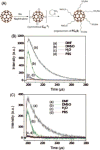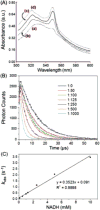Photodynamic Therapy with Hexa(sulfo-n-butyl)[60]Fullerene Against Sarcoma In Vitro and In Vivo
- PMID: 27398442
- PMCID: PMC4941956
- DOI: 10.1166/jnn.2016.10652
Photodynamic Therapy with Hexa(sulfo-n-butyl)[60]Fullerene Against Sarcoma In Vitro and In Vivo
Abstract
The hydrophilic molecular micellar hexa(sulfo-n-butyl)[60]fullerene (FC₄S), first synthesized in 1998 as a photosensitizer (PS) has been reported to exhibit high efficacy for singlet oxygen generation and antimicrobial photodynamic inactivation. The purpose of this study was to investigate the effects of photoactivated FC₄S for free radical generation and to mediate photodynamic therapy (PDT) of cancer in vitro and in vivo. The results demonstrated that following light irradiation, FC4S produced singlet oxygen, but after addition of electron donors such as ferrocytochrome c or NADH, FC4S also produced superoxide. The combination of FC4S with light irradiation was able to induce cytotoxicity to human fibrosarcoma cells and murine sarcoma 180 cells in vitro. Cell-killing was proportional to fluence as well as FC4S concentration. Photoirradiation by argon-ion laser after intraperitoneal injection of FC4S also resulted in inhibition of S180 tumor growth in vivo (up to 80% reduction of tumor volume). Hematological and blood biochemistry parameters of the cancer-bearing mice were improved by PDT. Based on these findings, we conclude that FC₄S has a great potential as a nanomedicine in PDT for cancer.
Figures




References
-
- Wilson BC, Patterson MS. Phys Med Biol. 2008;53:R61. - PubMed
-
- Arbogast WJ, Darmanyan PA, Foote SC, Diederich NF, Whetten LR, Rubin Y, Alvarez MM, Anz JS. J Phys Chem. 1991;95:11.
-
- Yamakoshi Y, Umezawa N, Ryu A, Arakane K, Miyata N, Goda Y, Masumizu T, Nagano T. J Am Chem Soc. 2003;125:12803. - PubMed
Publication types
MeSH terms
Substances
Grants and funding
LinkOut - more resources
Full Text Sources
Other Literature Sources
Medical
